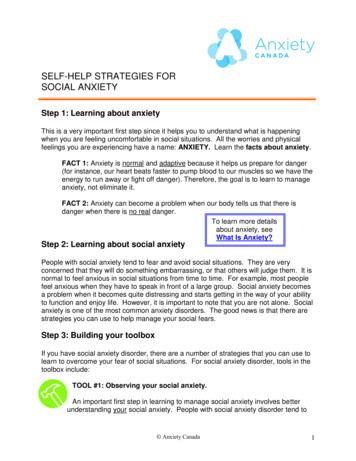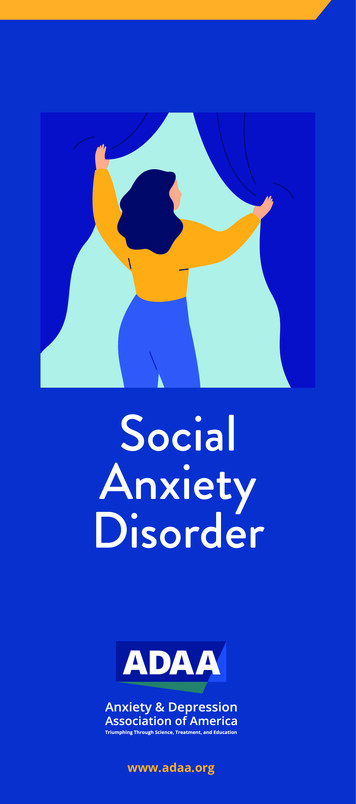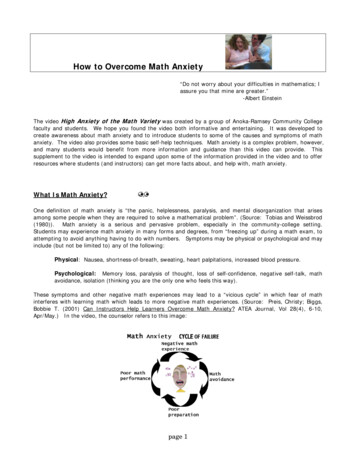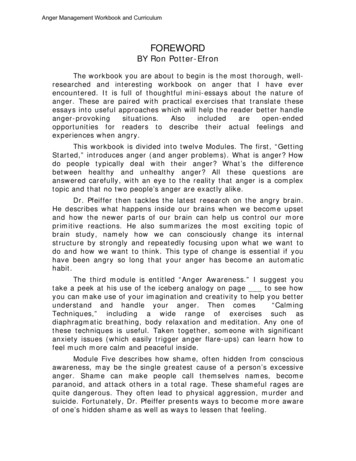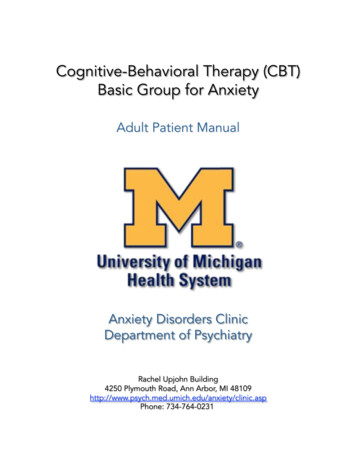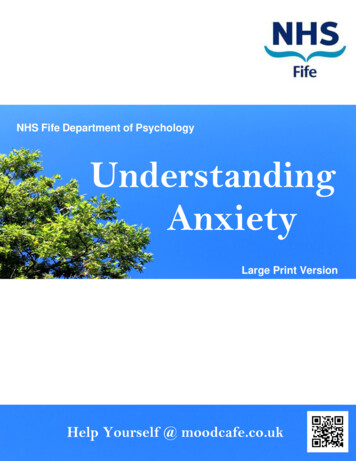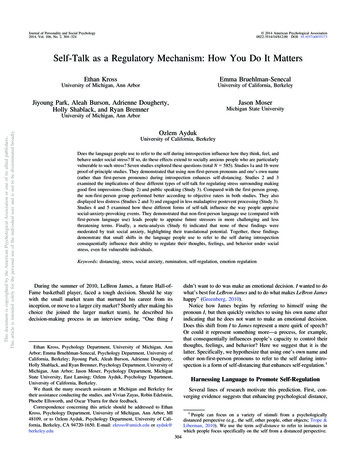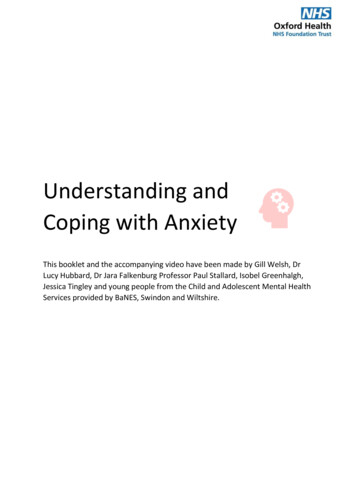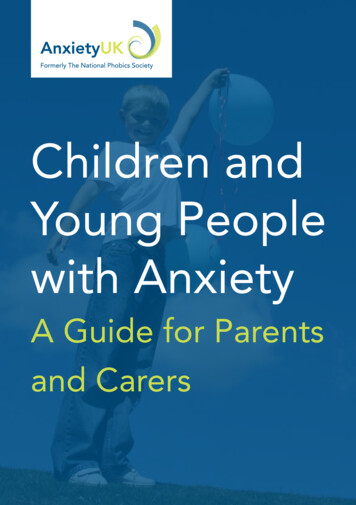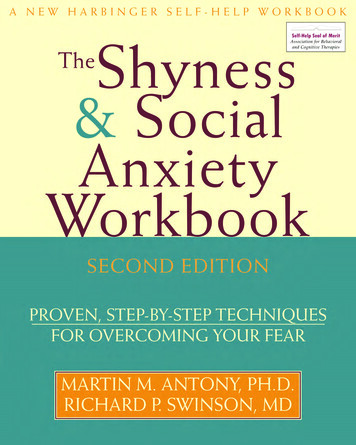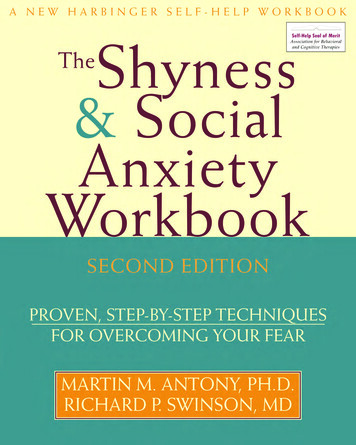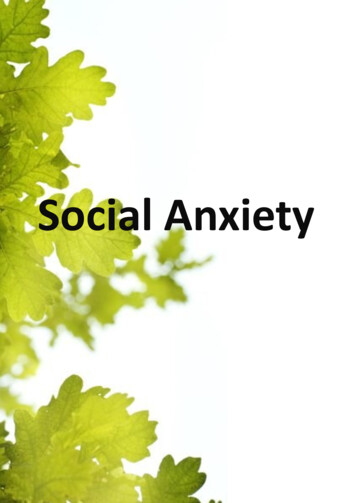
Transcription
Social Anxiety
Social AnxietyThis workbook can be used either alone or with the support of your Psychological WellbeingPractitioner.Module 1: Understanding Social Anxiety and What Maintains it.Module 2: Changing What You Do in Social Situations- Understanding Self Focus and Shifting your Focus of Attention- Understanding Safety Behaviours and Using BehaviouralExperimentsModule 3: Bringing it all Together and Relapse Preventionwww.talkplus.org.uk
Module 1Understanding Social AnxietyFight, flight or freezeOur bodies are finely tuned to protect us from danger. When we perceive a threat, adrenaline isreleased into our bodies to help us fight the threat, run away, or play dead. This is known as fight,flight or freeze. This is a natural response and we need it to keep safe.For people with social anxiety, social interactions are interpreted as a threat (we fear we willembarrass ourselves) and it’s our thoughts that set off our fight, flight or freeze response. Althoughthere is nothing physically dangerous about the situation, our bodies react to this false alarm in thesame way as a physical threat.With social anxiety, this means that before the event we worry about it and get that low level feelingof being nervous and tense. We probably start to think of ways to avoid it. During the event we mightexperience classic fight, flight or freeze symptoms; heart racing, breathing faster, feeling hot andsweaty, and shaking. After the event we tend to go over how badly we think we came across, thismay feel us feeling exhausted or we might get that sick feeling that something has gone wrong.Try this now:Imagine you have been told that you have to present a speech in one hour.What thoughts go through your head? How does your body react? Do you have an image of how youwill look?Did just thinking about it set off an anxious response?Symptoms of social anxietyDizzy orlightheadedThoughts terfliesUpset stomachTingling fingers ortoes
The Vicious Cycle of Social AnxietyThe example ‘vicious cycle of social anxiety’ shown below demonstrates ourthoughts about social situations, what we do (or don’t do), how our bodyfeels, and how we feel emotionally.ThoughtsI will . I am I did People will judge meEmotionsBehavioursAnxious and nervousWorryWorriedAvoid or EscapeFrustrated and sadBecome self –consciousPhysical symptomsButterfliesHeart racingFeel hot and sweatyThoughtsWhen we worry about an upcoming social situation we may find ourselves thinking ‘I won’t knowwhat to say’ or ‘I’ll do something embarrassing’ . In these instances we tend to think ‘People will notice I’m anxious’ and that they’ll judge us ‘They must think I’m weird, stupid, boring’. We may think‘everyone is looking at me’ and afterwards think ‘I looked like an idiot’.BehavioursWe might either avoid social situations or go along but endure them with discomfort. We may become very self conscious and use certain behaviours to avoid drawing attention to ourselves. Thesebehaviours may be things we do physically or they might be things we run through in our heads egrehearsing what to say.Physical symptomsWe may start to feel nervous, anxious and tense about the upcoming situation. In the situation wemay experience flight/flight /freeze reactions such as heart racing, feeling hot and sweaty, shakinghands or legs, breathing faster or needing to use the bathroom more.EmotionsWe may feel worried, anxious, frustrated, upset or even annoyed at ourselves or others.
STEP ONEMapping out your Vicious CycleFor some people, their social anxiety is confined to a few specific situationssuch as eating in public or public speaking. For others it might be almost allsituations involving interactions with others.What social situations provoke anxiety for you?People with social anxiety tend to anticipate how badly they think they willcome across in a situation, focus on how they think they are coming across inthe situation, and then afterwards go over and over what they did in the situation. It’s like they always have a spotlight on their thoughts, bodies, and behaviour.To start understanding what is maintaining the problem, let’s break this down into three separatecycles – what happens before the event, what happens during the event, and what happensafter the event.Before the event we might worry about what we’ll say or do, or that we will somehow embarrassourselves in front of others.During the event we might start to notice our physical symptoms of anxiety and behave in acertain way to try to prevent people noticing. We probably become more self conscious.Afterwards we go over and over what we think happened, what we believe people thoughtabout us and focus on what we think went wrong.
Before the Situation or EventThink of a recent time that you felt anxious about an upcoming event, whatwas it? Imagine that that event or something similar is coming up again.Ask yourself: What am I worrying about or predicting will happen? What is the worst thing about that happening? Do I have an image in mind of how I think I will look? How does my body feel? What will I do to reduce the anxiety I am feeling? How do I feel emotionally?ThoughtsBehavioursEmotionsPhysical symptoms
During the Situation or EventImagine you are now in that situation.Ask yourself:What do I think people are noticing/thinking?What is going through my mind? What is happening?What do I notice in my body?What am I doing to reduce the anxiety I am feeling? Do I do anything to stop people noticing anyphysical anxiety?As I become more anxious, where do I focus my attention?ThoughtsBehavioursEmotionsPhysical symptoms
After the Situation or EventWhat happens after the situation?Ask yourself:What do I think happened?How do I think I came across?What do I think people thought of me?What symptoms bothered me?How do I feel emotionally?Do I have an image of how I came across?Am I now dwelling on what happened?ThoughtsBehavioursEmotionsPhysical symptoms
How Does Each Cycle Affect the Situation orEvent?BEFOREI worryI thinkI imagine myself lookingMy body feelsEmotionally I feelAs I enter the situation I already expectPhysically I feelDURINGI start to noticeI try to hide any physical symptoms of byI focus on my thoughts ofTo prevent myself feeling II think people will notice that I amAfter the situation IAFTERI go overI thinkEmotionally I feelPhysically I feel“I never want to do that again”
ExampleSam has been invited to go out with colleagues after work on Friday. She doesn’t really want to gobecause she worries about what she will say and that she will look nervous. She has avoided going inthe past but feels that she can’t make an excuse this time. She goes and feels very awkward.BEFOREI worry about what will happen, what I’ll sayI’m going to embarrass myselfI imagine myself looking bright red and shakingMy body feels nervous/on edgeEmotionally I feel anxiousSam goes into situation already expecting the worstShe is experiencing mild fight, flight or freeze symptomsDURINGI start to monitor my performance and I become moreself-consciousI try to hide any symptoms of blushing by putting onlots of make upI try not to make eye contactI look for cues to confirm my fears ‘They are laughing,probably at me’I can’t think of anything to sayI want to leave as soon as I canSam leaves the situation but continues to replay events in her mindAFTERI must have seemed so boring and weirdI can’t believe I said thatI feel sick and exhaustedI dwell on how bad I think it was
How Did Each Cycle Affect Sam’s Evening?BeforeIn this example we can see that Sam is worrying before the event and is already imagining how shewill not fit in or somehow embarrass herself. As Sam enters the situation she is already feeling nervous and anxious, she has an image of herself going bright red and being humiliated.DuringDuring the event Sam is looking for cues that confirm how badly she thinks she is coming across.Her attention shifts inward to her internal critical thoughts and how her body feels. To avoid thisfeared reaction she starts to use certain ‘safety behaviours’; crossing her arms, not making eye contact, going on her phone. Sam doesn’t realise that what she does changes what happens in the situation and can influence how people relate to her. Her body language makes it appear that she is notinterested in what is happening around her, and therefore people are less likely to talk to her. Alsoby avoiding eye contact she can’t see when people are interested in what she has to say. She leavesthe situation as soon as she can (without drawing too much attention to herself).AfterAfter the event Sam carries out a ‘post mortem’ of how badly she thinks it went. She goes over andover what she said, how she thinks her body showed how anxious she was, and what she assumespeople thought of her. This is based on her perception of how she felt rather than what actually happened. Sam also has an image of how she thinks she looked, she thought she looked bright red andwas shaking like a leaf.Can you see from this example that Sam is worrying about the event before it happens, closely monitoring herself during the event, and then afterwards going overand over what she thought happened during the event.It therefore makes sense to have a good look at what happens during the event asthis is where the anxiety ultimately stems from.We will look at this in MODULE 2 — Changing what you do in Social Situations
Module 2Changing What You Do in Social SituationsSo far we have looked at 3 vicious cycles: before, during and after a social situationor event. Research suggests that understanding what happens during the social situation is the key to changing social anxiety.During the situation/eventThere are 2 main areas that maintain social anxiety in the situation and they involve internal focus orself-consciousness, and the use of safety behaviours. If we can break these cycles we can change thepatterns that keep social anxiety going. We will look at each one separately .Examples:Self Focussed- SelfConscious ThoughtsI don’t know what to sayI am going redI can feel my heart racingPeople are judging meSafety BehavioursEscapeDon’t make eye contactAvoid talking about myselfTry to blend into the backgroundI must look stupid Think back to your example of thoughts and behaviours during a situation.When you were worried that the outcome that you fear was happening, what happened toyour attention?Did you become more self conscious?You may have noticed that when you are in a situation and start feeling anxious, your attention is lesslikely to be on what’s happening around you and more likely to be focussed internally – on what youare thinking or feeling and what your body is doing. Being internally focussed is the worst place forsomeone with social anxiety, as it takes you away from the present and focuses on your negative perception of yourself and the situation. The next step looks at breaking the cycle of internal focus bylearning to be in the present and turning your attention outwards.
STEP TWOExternal focus and shifting your focus of attentionPart A - EXTERNAL FOCUS (Being Present)Worrying and focussing on internal thoughts and feelings takes us away from the present and intoour own minds. We can use our senses to keep us in the present and to notice what is happening inthe external environment.The first step is to practice this technique in a ‘non-threatening’ or neutral situation. Like all skills ittakes practice and if you can, try practicing for around 10 minutes a day.1. Becoming aware of the range of different sights and sounds around you-Practice inside for about 2 minutes at a time- Listen to a song or the radio, in turn pay attention to the different instruments that are playing(guitar, drums, bass, piano, voice, etc.)- Sit quietly and pay attention to the sounds in the room and any sounds you can hear outside- Pay attention to what objects are around you, what are they, what colours can you see, how isthe light falling on an object? What would it feel like to touch these objects? Would they behard or soft, smooth or textured?If you find your mind wondering, that’s ok, just bring it back to what you can see or hear.- Practising outside- Go for a walk, pay attention to the sounds around you. What sounds can you hear nearby, whatsounds are further away? Can you hear cars, people, birds, silence?- Now pay attention to the buildings, plants, animals, people around you. What colours can yousee? What are the different textures aroundyou, how would they feel?
2. Switching your attention between the different sights and soundsYou can do this equally well indoors and outdoorsChoose several different sounds.Start by focussing on one of the sounds, noticing all you can about it and letting it fill your awareness- After following the first sound for a while, shift your attention to another sound and then become absorbed in following that.- Do the same for a third sound. Move on to objects, light, textures, colours, etc.3. Filling your attention with the external environmentOnce you have spent some time focussing on a number of different sights and sounds try to becomeaware of them all at once and let them fill your attention.Don’t worry if your attention drifts back on to yourself, simply notice this and then shift your attention back to the outside world.Use Worksheet ONE on the following page to record your experiences.Example:Date/timeSituationWhat I focussed myattention onMinsAny comments12/11/18At home having acup of tea5 minsIt was harder than I thought mymind kept wandering13/11/18Listening to a songat homeThe different sounds inside and the heat of thetea in my handsI listened to the piano andthen the lyrics4 minsIt was really interesting, I haveheard this song many times beforeWhen you notice that you are worrying about an upcoming situation(focussing on the future) or going over a past event (focussing on thepast) use the external focus technique as a way of distracting you fromyour thoughts and coming back to the present.
WORKSHEET ONEUsing the External Focus TechniqueDate/timeSituationWhat I focussed myattention onMinsAny comments
Part B—SHIFTING YOUR FOCUS OF ATTENTIONThe most important part of the technique is starting to use it in different situations. Thistime it is not for the purpose of distraction but more importantly it’s to keep you involvedin what is happening around you. That may be focussing externally on what someone isactually saying to you, or noticing what other people are doing, what they are wearing,what music is playing etc.Try just observing and engaging with what is happening without making a judgementabout the situation or about yourself.Your attention may turn back to yourself, and that’s ok. It’s the ability to notice where your thoughtsare, then switch it!Have you ever noticed that when you focus on a physical sensation it starts to feel worse? For example, focus on a niggly pain in any part of your body, really focus on it. What happens; does it get better, worse or stay the same? Chances are it gets worse. The same thing happens when we focus onbodily symptoms of anxiety, eg. Sweating, shaking etc. By focussing on them they get worse notbetter.What about when you start to overthink what you are going to say. Does it help you get involved inthe conversation or does it actually make things worse? Can’t keep up, can’t find your words, stumble, or stutter, sound shaky?Shifting your focus of attention in social situationsFirst—Try practising shifting your focus of attention in ‘non-threatening’ or neutral social situations.For homework try applying it in social situations e.g next time you are talking with a friend/familymember/colleague.How did it feel?Once you have practiced shifting your attention in neutral situations, try gradually using it insituations that you find more challenging.Use the Worksheet TWO on the following page to record your experiences.Example:Date/timeSituationWhat I focussed myattention onMinsAny comments14/1/19Making a tea at workWhat my colleague wassaying5 minsI tried not to focus on what to say. Because I was listening more carefully Ifound it easier to respond. I actually feltmore relaxed. I was surprised.
WORKSHEET TWOShifting Your Focus of AttentionDate/timeSituationWhat I focussed myattention onMinsAny comments
Understanding Safety behavioursSafety behaviours are actions that we carry out in order to prevent a feared outcome. In the short term they provide us with a sense of relief from feelings of anxiety, but in the long run they are ultimately unhelpful. They stop us learning that wecan cope, or even worse – they may actually influence the situation and unintentionally contribute to the feared outcome happening!The safety behaviours of avoidance or escape give short term relief but re-inforce the idea that wecan’t cope in certain situations. Safety behaviours such as keeping arms crossed to stop people seeing you are sweating or shaking, reinforce the idea that you only coped because of that behaviour.Ultimately safety behaviours keep anxiety going.ANXIETYReinforces theidea that youonly copedbecause youused the safetybehavioursSAFETYBEHAVIOURSShort term reliefCan makethe fearedoutcomemore likelyto cometrue.People maynotice yourbehaviourmore.UNINTENDEDCONSEQUENCESBehaviour has a negativeimpact on the situationYou can learn more about avoidance and safety behaviours by watching our video moduleswww.talkplus.org.uk/anxiety-video-modules
STEP THREEWhat are some of your Safety Behaviours?Think back to your vicious cycle during the situation. Do you use any of the following safetybehaviours, tick the ones that relate to you. Add any other ones that you have noticed.Avoidance - if I don’t go I won’t be anxious and I won’t embarrass myselfEscape – I can’t handle this anymore, I have to get out before people notice I’m anxious or I dosomething really stupidAvoid eye contact – if I don’t look at people, they won’t talk to me/notice me or see that I’mnervousGo on my phone or have my headphones in – if I look like I’m busy I won’t look silly for notbeing involved in the conversationRehearse what I’m going to say, check things before I say them – that way I won’t say anything wrongDon’t say anything – if I don’t speak up I can’t say anything embarrassing, they won’t knowwhat I’m really thinkingAvoid talking about myself – that way they won’t think I’m weird or have different opinionsAsk lots of questions – deflect attention away from myselfSay too much, try keep the conversation always going – I have to keep talking or they’ll thinkI’m boringDrink too much – if I drink I’ll feel more confidentKeep my arms crossed – people won’t see I’m sweating or shakingCover my face with my hair/hand/look away so people won’t see I’m blushingWear clothing that will cover up that I’m sweatingTry to control shaking by crossing my arms or holding them togetherSpeak really softly – other people won’t hear what I’m sayingAvoid eating in front of others
STEP FOURSafety behaviours and their unintended consequencesSafety behaviours can ‘contaminate’ the situation and actually make the situation and anxiety worse.List your safety behaviours and their unintended consequences or impact on the situation.Safety BehaviourSam’ example—avoiding eyecontactReason for using thesafety behaviourPeople won’t look at methat means they won’t askme any questions, so Iwon’t feel awkwardUnintended consequence or impacton the situationBecause Sam is not making eyecontact with people she looksreally bored and uninterested inmaking conversationSam feels left out as people are nottalking to her.Sam doesn’t see cues that peoplewould be interested in talking to her.Re-enforces the idea ‘I shouldn’tmake eye contact’
STEP FIVEReducing safety behaviours by experimenting with graded tasksNow that you are aware of your safety behaviours, how can you go about reducingthem? Which one would be easiest to try dropping, which one would be the hardestto drop?Which of your safety behaviours has the most impact on the situation?Create a hierarchy of tasks to test out what happens when we drop safety behaviours. Choose thesafety behaviour that would be easiest to drop first and create tasks that would be easy, moderateand difficult.Safety Behaviour to DropGraded task to test what happensExample:Easy—make eye contact with the shop keeper when I buy something atthe local shop.Avoiding eye contactModerate—say hello and make eye contact with a work colleagueDifficult— make eye contact when talking to my bossEasy Moderate—Difficult—Easy —Now that you know what your safety behaviours are and how they may influence a situation, it isnow time to test out what happens if you don’t carry them out. We will do this in a gradual way byusing Behavioural Experiments in Step Six.
STEP SIXBehavioural ExperimentsWe know that people who are socially anxious tend to: Over estimate the likelihood that something will go badly, Over estimate how bad it will be, and Under estimate their ability to manage or cope.A Behavioural Experiment is a way of testing out specific predictions about a socialsituation. This allows us to test out what happens when we change or reduce oursafety behaviours.An example prediction might be: If I make eye contact with someone, they will ask me aquestion, I won’t know what to say, I’ll go bright red and they will think I’m stupid.With Behavioural Experiments it is important to take notice of the situation, notwhat you are thinking or feeling. Think of it like gathering evidence for or againstyour prediction.Remember to use external focus, and if you notice your thoughts turning inward, thenshift your focus of attention to what is happening around you.Creating a Behavioural Experiment1.Be specific about your prediction and rate how strongly you believe in it (0-100)%2.Design your experiment, what you will do to test your prediction. It may be helpful to decidewhen, where and who.3.Carry out the experiment4.What happened, what did you observe?5.What have you learned?6.Rate how strongly you now believe in your original prediction.Start carrying out your Behavioural Experiments in WORKSHEET FOURYou can learn more about Behavioural Experiments by watching our video moduleswww.talkplus.org.uk/anxiety-video-modules
your beliefin this prediction %What do you expectto happen?How would you knowif it came true?RatePredictionOutcomeHow could you test this What happened?out?Was your prediction accuWhat safety behaviour rate?do you need to drop?ExperimentHow likely is it that your prediction willhappen In the future?What did you learn?LearningWORKSHEET FOUR—Behavioural Experimentsyour originalprediction %Re-rate
your beliefin this prediction %What do you expectto happen?If I speak loudly, I will 70%draw attention to myself and everyone willlook at me.If I make contact80%with someone, theywill ask me a question, I won’t knowwhat to say, I’ll blushand they’ll think I’mstupidHow would you knowif it came true?RatePredictionOutcomeNext time I meet afriend for a coffee I willtalk at a normal volumeand take notice of whatis happening around me(using external focus).I had a coffee with my friendat a local café. I spoke loudlyenough for my friend to hearwithout leaning in and it wasloud enough that other people could hear. No one elseseemed to notice me or care.I will make more eye I did it this afternoon. I had tocontact in the tea room deliberately go into the teawhen speaking to colroom when someone elseleagues this afternoon. Ifwas there to make sure Ithey ask a question, Icould do the experiment.will focus on what they Someone I didn't know particare saying (external foularly well asked me aboutcus) and just say whatmy weekend. I said that Iever I feel like at thewent for a run (which wastime (dropping my safe- true) and asked them aboutty behaviour of plantheir weekend.ning)How could you test this What happened?out?Was your prediction accuWhat safety behaviour rate?do you need to drop?ExperimentSam’s Behavioural Experimentsyour originalprediction %Re-rateI learned that most people are just concen- 15%trating on their own conversations an whatever they are doing. If they did notice me itwas only fleeting, I guess people have tolook somewhere and sometimes it might bein my direction.Well my negative prediction that I wouldn't 20%know what to say was incorrect. It was quitea nice conversationThere is no reason why they should thinkI'm stupid, so I don't believe that at all now!How likely is it that your prediction willhappen In the future?What did you learn?Learning
Module 3Bringing it together and Relapse PreventionWhat have you learned about yourself and social anxiety? Were you making assumptions based on your own views? Were you ignoring times when you coped well andjust focussing on things you thought went badly? Could you be kinder to yourself?Throughout this booklet and we have looked at four main areas to help manage social anxiety: Understanding and mapping out the vicious cycle that maintains social anxiety External focus technique and shifting attention Understanding Safety Behaviours and their Unintended Consequences Using Behavioural ExperimentsThink back to MODULE ONE when you mapped out your personal cycle of social anxiety.You looked at anticipating an event and worrying about how you might come across. This worryaffects how you feel, how your body reacts and what you do.Next you saw what happens during a social situation or event, how you think you are coming across,how you expect that people are judging you, and where you focus your attention. We also looked atbehaviours, things you do or don’t do in those situations.We then looked at how going over what you think happened affected how you feel, and therefore howyou felt about going into a similar situation again.In MODULE TWO you looked at being present and turning your focus outwards using the ExternalFocus Technique. We then looked at shifting your attention in social situations, thereby engagingmore in what was happening around you rather than focussing on how your body felt, or what youwere thinking.We looked at Safety Behaviours and how they can re inforce social anxiety as they never allow youthe chance to discover that you can cope without using them. We looked at how safety behaviourscan also have a negative impact on a situation and actually contribute to the thing you fear actuallyhappening.To test out your predictions about social situations you used Behavioural Experiments in a gradedway.To bring all of this learning together it can be helpful to complete a Relapse Prevention Plan on thefollowing page.
My Relapse Prevention PlanWhat were your main problems at the beginning of treatment?What kept those difficulties going?What have you learned in treatment?What progress have you made? How are things different now?What challenges do you anticipate in the near future?What are your early warning signs that might indicate a lapse?What are your future goals?How can you be your own therapist? What could you do on a regular basis to maintain this progress?
What Sam learned about herself and social anxietyUnderstanding what maintains social anxietySam realised that by getting worried and overthinking what might go wrong prior to a social situation, she was getting very anxious. She could feel this anxiety in her body and always thought aboutthe worst possible outcome.External Focus and Shifting AttentionShe started to use the external focus technique to distract herself when she noticed she was worrying.In social situations or even just walking down the street, she practiced shifting attention to take notice of what was happening around her. When she was more aware of her surroundings rather thanfocussing on her thoughts, she noticed that most people were focussed on their own situation, not onher.Understanding how safety behaviours impact the situationBy understanding her safety behaviours, she started working on dropping the ones that were havinga big impact on how she came across in social situations. She tested this out using behavioural experiments.Behavioural ExperimentsInitially she tried making eye contact with a shop keeper, a stranger on the bus and then with hercolleagues in the lunch room. When she made eye contact she realised that people were generallyhappy to talk to her.She also found that she was more able to keep up with conversation as she wasn’t always secondguessing herself and rehearsing what she was going to say.The hardest behaviour to drop was speaking really softly, but she realised that when others couldn’thear her, it actually made things worse not better. She found that this meant she had to repeat herself or people leaned in to hear what she said. She tested this out by speaking louder in a range ofsituations.Sam realised that previously she had been assuming what other people thought about her, and thiswas largely based on her own negative views. She also realised that it is unhelpful to care too muchwhat people think. She started noticing moments that did go well rather than just focussing on theones that didn’t."I have realised that I can’t control what people think. It's really unhelpful to try to as itgets me in a vicious cycle of internal focus and safety behaviours and then worry, avoidance and overthinking. I still feel a bit anxious in social situations but CBT has reallyhelped me be more confident and I’m now doing more things that I want to do". Sam
Sam’s Relapse Prevention PlanWhat were your main problems at the beginning of treatment?I was always worried that I would do or say something embarrassing in social situations. I thought Iwouldn’t know what to say and I would go red. I worried that if I looked anxious then people wouldthink I was boring and weird.What kept those difficulties going?I was
Social Anxiety This workbook can be used either alone or with the support of your Psychological Wellbeing Practitioner. Module 1: Understanding Social Anxiety and What Maintains it. Module 2: Changin
